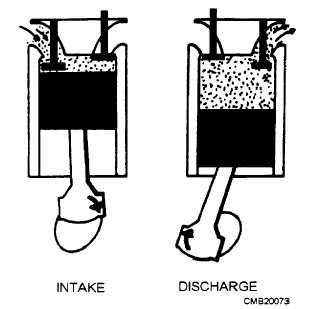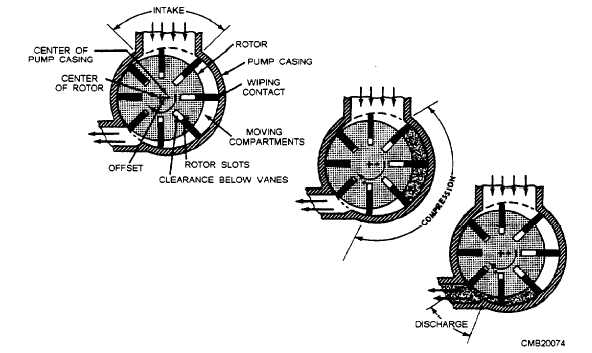most systems the compressor is part of the system with distribution lines leading from the compressor to the devices to be operated.
Compressed air systems are categorized by their operating pressure as follows:
High-pressure (HP) - 3,000 to 5,000 psi
Medium-pressure (MP ) - 151 to 1,000 psi
Low-pressure (LP) - 150 psi and below

Figure 3-51. - Intake and compression strokes in a reciprocating compressor.
HEAVY-DUTY AIR COMPRESSORS
Compressors are used in pneumatic systems to provide requirements similar to those required by pumps in hydraulic systems. They furnish compressed air as required to operate the units of the pneumatic systems.
Even though manufactured by different companies, most compressors are quite similar. They are governed by a pressure control system that can be adjusted to compress air to the maximum pressure.
Compressor Design
The compressor unit may be of the reciprocating, rotary, or screw design.
The reciprocating compressor is similar to that of an automotive engine. They may be air- or liquid- cooled. As the pistons move up and down, air flows into the cylinder through the intake valve. As the piston moves upward, the intake valve closes and traps air in the cylinder. The trapped air is compressed until it exceeds the pressure within the collecting manifold, at which time the discharge valve opens and the compressed air is forced into the air manifold (fig. 3- 51). The reciprocating compressor is normally connected to the engine through a direct coupling or a clutch. The engine and compressor are separate units.
The rotary compressor has a number of vanes held in captive in slots in the rotor. These vanes slide in and out of the slots, as the rotor rotates. Figure 3-52 shows an end

Figure 3-52. - Compression cycle in a rotary compressor.
Continue Reading